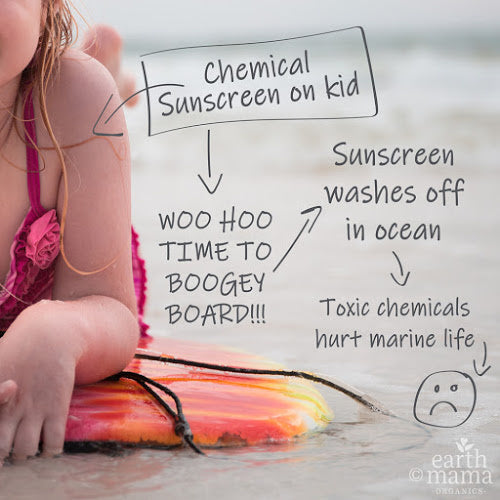If you’ve gone sunscreen-shopping in 2019, you’ve probably noticed companies touting their SPFs as “reef-safe” or “reef-friendly” — right there on the front of the bottle. It’s a claim that sounds and feels good, but. Um. What exactly does it mean?

Here’s some background intel: it seems the term “reef safe” stems from a public information campaign called Marine Safe, run by scientists at the International Programme on the State of the Ocean. In 2012, they found that a significant amount of oceanic pollution originates from toxic chemicals found in personal care products. For example: some sunscreens containing chemical UV filters are toxic, and have negative effects on corals and other marine life. The National Park Service estimates between 4,000 - 6,000 tons of sunscreen ends up in the world’s oceans every year.
*Insert record scratch sound here.
Soo…we’re out here putting stuff on ourselves and our kids that literally kills coral? This statistic raises all sorts of red flags. For the coral reefs, sure, but honestly? If it’s bad for the coral reefs, it’s very bad for humans, too.
The Marine Safe scientists are speaking our language — we’ve been talking about the same thing since 2002 (about pregnant and breastfeeding women, and their babies, but the idea is the same). The good news? The campaign is starting to take hold: in 2018, Hawaii became the first state to ban the sale of two common chemicals causing harm to marine life: oxybenzone and octinoxate. The city of Key West, Florida did the same — both laws go into effect in 2021. In the business world, REI and other retailers agreed to stop carrying products containing oxybenzone — and oxybenzone only — beginning in 2020. This is fantastic progress, because those two chemicals are no bueno at all — for people AND the planet.
But here’s the rub: a sunscreen without oxybenzone or octinoxate does NOT equal reef-safe. Or baby safe. Those two chemicals are the only ones that have been banned. There’s a whole list of questionable ingredients you absolutely should stay away from — scroll to the bottom of this post to review. And we know you know this, cause y’all are a bunch of smarty pants, but just in case: when you read ingredients, employ caution and an eensy bit of skepticism. Because guess what? Companies can list whatever ingredients they feel like listing. The only way to know for sure is to look for a third-party verification.
So back to the issue at hand: What DOES reef-safe mean? The answer is, sadly, not much. In essence, reef-safe is a marketing term: it’s undefined, and in the US, unregulated by the government. Sunscreen manufacturers are not required to test or confirm their products are safe for marine life. And at this stage in the game, there aren’t any reef-safe certifications recognized by the government — and even if they were, there aren’t any third-party organizations to help verify the claim.
It’s a little misleading, don’t you think? Just a little bit. Ok, a lot misleading. But don’t worry — there are trustworthy and safe sunscreen options out there ( cough Earth Mama Mineral Sunscreens cough). Here’s our recommendation for finding a sunscreen that’s not only safe for your preggo belly or chubby li’l baby’s arms and legs (under an umbrella, hat, long-sleeves and pants, obviously) — but for fish, reefs and sea turtles, too:
- You read your food labels closely — so turn that eagle eye on your sunscreen label. Pay attention to the active ingredients and the non-active ingredients, too.
- Choose mineral sunscreen with non-nano zinc oxide or non-nano titanium dioxide. Full stop. These are natural minerals that act as a barrier, sitting on top of the skin and scattering rays — and non-nano is the key phrase here. This means the particles aren’t small enough to sink into your skin. More on that here.
- If a sunscreen claims to be organic or have organic ingredients, look for a certification — like the one from NSF/ANSI 305 Organic Standards for Personal care — that’s been verified by a third party.
- Look up the sunscreen on the EWG Skin Deep Cosmetics database, and find products rated a 1 (the best rating you can get). And again, be your smart self and go beyond the rating — review those ingredients.
Because officially recognizing oxybenzone and octinoxate as marine-toxic (and people-toxic) chemicals is just the beginning. If you take a look at most sunscreen ingredients, there are a whole host of chemical sunscreens (UV filters) and preservatives that have been proven harmful to marine life — and the list keeps growing. And the more we learn, the more we understand the potential damage many of these cause to every living thing on this blue planet we call home.
THE WHOLE HOST OF SUNSCREEN INGREDIENTS THAT ARE NOT, IN ANY WAY, CHILD SAFE OR REEF SAFE.
These chemicals show varying levels of scientific evidence of harm to marine environment:
- Oxybenzone
- Octinoxate
- Triclosan
- Nanoparticles – zinc and titanium dioxide
- Parabens
- Octocrylene
- 4-Methylbenzylidene-camphor (4MBC)
- Homosalate
- Octisalate
- Microbeads (plastic)
- Enzacamene
- Para-aminobenzoic acid (PABA)
QUESTIONABLE CHEMICALS YOU SHOULD STILL STAY AWAY FROM, BUT NEED MORE RESEARCH
- Phenoxyethanol
- Avobenzone
- Artificial fragrance (and the thousands of chemicals that can be hidden there)
- Petrolatum/mineral oil
- Potassium sorbate
- Chloroxylenol
LEARN MORE



